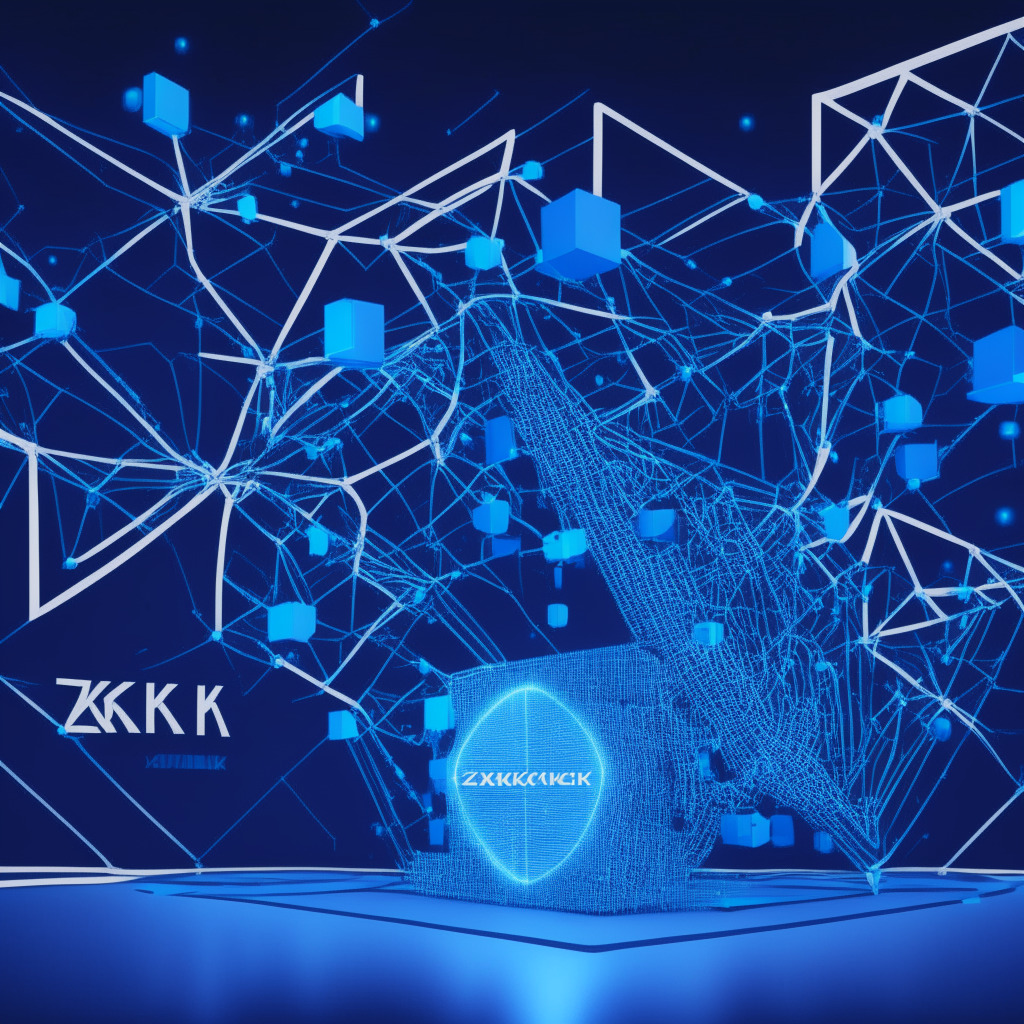“Despite the secure nature of blockchain technology, recent security breaches, particularly in nonfungible token platforms, have raised skepticism. While safety measures are intensifying, these incidents remind us that blockchain, while a fortress of safety, isn’t entirely immune to manipulation.”
Search Results for: Blockchain technology
Jury Selection Wraps Up for Crypto Magnate: A Precedent for Blockchain Technology Lawsuits
“The trial against former CEO of cryptogiant FTX, Sam Bankman-Fried, signals a pressing need for regulatory mechanisms in the volatile crypto market. This case, tied to grave criminal charges and the subsequent insolvency of FTX, could prompt reforms balancing libertarian crypto ethos and required regulations protecting investments.”
Revolutionizing Scientific Funding: The Emergence of DAOs and Blockchain Technology
“Decentralized Autonomous Organizations (DAOs), utilizing blockchain technology, are advocated by Nature science journal as transformative in securing funds for underfunded research fields. By disrupting traditional funding models, DAOs democratize funding procedures, potentially realign resources from only prestigious institutions to more varied sectors.”
Unlocking the Future of AAA Gaming: The Role of DApps and the Actor Model in Blockchain Technology
“While blockchain technology creates innovative opportunities in gaming with decentralized applications (DApps), it faces challenges in complexity, scalability, and performance. However, the ‘actor model’- a communication model that facilitates parallel computing and asynchronous messaging within a blockchain protocol, promises improved development efficiency, better throughput, resilience against network conditions, and efficient event-driven architectures. This model might enable developers to create powerful AAA-grade DApps, balancing immersive experiences with user-friendly expenses.”
Leased Proof-of-Stake: Game-Changer or Just Another Player in Blockchain Technology?
“Blockchain technology introduces Leased Proof-of-Stake (LPoS), an innovative mechanism aimed at overcoming crypto mining complications. LPoS allows tokenholders to lease their tokens to validator nodes, improving their chance at generating new blocks and sharing transaction fees. While offering benefits such as decentralization and fixed tokens, LPoS also maintains control by restricting trade or transfer of leased tokens.”
Unveiling the Future: How Polygon’s $1 Billion Bet on ZK-Rollups Revolutionizes Blockchain Technology
Polygon co-founder Sandeep Nailwal believes strongly in the potential of zero-knowledge proof (ZK-proof) technology for Ethereum scaling, as evidenced by allocating $1 billion towards its development. Nailwal proposed a unified scalability system where recursive ZK-proof technology merges different blockchain ZK-proofs into a common layer, dramatically improving cross-chain transaction times.
Deciphering Ripple’s Future: Centralization vs Decentralization Debate in Blockchain Technology
Ripple Labs’ digital currency, XRP, has a chance to redefine its closed structure following a recent US judge ruling that XRP wasn’t a security when sold to public. Ripple stands to gain economically from building an effective ecosystem, potentially transitioning from centralized to decentralized autonomous organizations. Greater decentralization may also aid in navigating partnerships with traditional entities.
Shifting Tides in the Crypto Market: From Mining Crises to Advancements in Blockchain Technology
“Bitcoin trading volumes have dipped below the $5 billion mark due to an ongoing power crisis in Texas impacting cryptocurrency miners. However, increasing signals from influential parties indicate growing acceptance of digital currencies like blockchain-based tokens from JPMorgan aimed at revolutionizing fund transfers.”
Navigating the Tightrope: Federal Oversight and the Future of Blockchain Technology
Vice Chairman of the Federal Reserve, Michael Barr, in a fintech event, emphasized the need for regulatory oversight in the swift adoption of blockchain technology. He discussed the basic research into Central Bank Digital Currency (CBDC), potential for stablecoin legislation, and the significance of balancing innovation with potential risks.
Binance, Blockchain Technology, and the PopcornSwap Scandal: A Dive into Exchange Security and Decentralization Debates
The PopcornSwap scam incident on Binance casts light on the security measures taken by crypto exchanges and questions the transparency and security of blockchain technology. It demonstrates that despite claims of decentralization, exchanges can exert control over users’ assets, challenging the ethos of blockchain-based systems.
Unmasking yPredict: A Data-Driven Trading Solution Built on Blockchain Technology
“yPredict, a trading research and analysis platform, combines AI and financial expertise, offering data-centric tools for insightful investment choices. It runs on the Polygon Matic chain using YPRED tokens, which allow access to predictive models and participation in the platform’s decision-making process. Its diverse analytical tools go beyond price predictions.”
Coinbase vs SEC: Unfolding Regulatory Tensions and the Future of Blockchain Technology
“While Congress actively drafts cryptocurrency regulations, the SEC persists on its own path, complicating the regulatory landscape. This raises questions regarding the SEC’s authority over digital assets. Recent losses to Ripple and Grayscale intensify the need for regulatory clarity, underlining the SEC’s inconsistencies in classifying cryptocurrencies.”
Shibarium’s Launch: A Game Changer in Blockchain Technology Despite Initial Setbacks
Shibarium, an Ethereum layer-2 network touted for effective blockchain solutions, is nearing its public debut after successfully operating in private mode. Despite encountering operational hiccups during the testing phase, the Shibarium team has implemented safety measures to tackle potential issues due to sudden traffic surges, promising a seamless roll-out.
OP Stack Vs. ZK Rollups: Navigating the Future of Layer-2 Blockchain Technology
Major crypto enterprises like Coinbase, Binance, and a16z are setting up their own “layer-2” blockchain networks using OP Stack, despite the belief that promising layer-2 solutions will come from “ZK rollups” and not optimistic rollup technology. However, the choice of OP Stack may be due to its ease of setup. ZK rollups, while promising, require advanced hardware and high energy consumption.
Stellar Joins Bytecode Alliance: A Shift from EVM to Wasm in Blockchain Technology
“Stellar, a globally recognized payments network, has joined the Bytecode Alliance, with a mission to advance the development of WebAssembly (Wasm). Wasm, initially used for browser applications, offers unique resiliency, making it an attractive alternative to Ethereum’s Virtual Machine (EVM) for executing smart contracts. Ultimately, Stellar’s goal is to impact Wasm development standards to benefit the broader Blockchain community.”
Revolutionizing Multiple Industries: The Future of AI Intertwined with Blockchain Technology
“The combination of AI and blockchain technology could revolutionize industries by powering secure, self-improving data streams. However, integration challenges include scalability, privacy, and the need for skilled personnel to navigate AI algorithms and blockchain protocols.”
Kenya Investigates Worldcoin: Blockchain Technology’s Regulatory Challenges Unveiled
“The Kenyan government has assembled a committee to carry out an investigation into the Worldcoin crypto project, raising concerns over its security implications. Simultaneously, courts have postponed Worldcoin’s activities following a lawsuit filed by the office of the data commissioner. Governments worldwide are becoming increasingly vigilant about potential risks associated with cryptocurrency projects, reflecting the growing mainstream acceptance of blockchain technology.”
Blockchain Technology: Revolutionary Rewards or Troublesome Trade-offs?
“Blockchain technology has made significant strides, providing security, transparency, and fast transactions while also facing challenges like energy consumption, security loopholes, and regulatory issues. Its potential and drawbacks set the pace for its widespread reception, urging us to tread with caution.”
Cross-Chain Interoperability: Unlocking the True Potential of Blockchain Technology
This article discusses the transformative power of blockchain technology and the challenges it faces in attaining cross-chain interoperability. The problems include lack of standardized protocols, insufficient demand, complicated user experiences, and a deficient comprehension within the global crypto ecosystem. The author advocates for concerted efforts to simplify interoperability and enhance blockchain potential.
Balancing Act: Unpacking the Prospects and Challenges in the Adoption of Blockchain Technology
“Blockchain technology guarantees transparency and decentralization, with substantial benefits in security and transparency. On reverse side, it also faces hurdles like market speculation, financial unpredictability impacted by cryptocurrencies prices fluctuation; and problems raised by blockchain’s immutable nature which makes correcting erroneous transactions almost impossible.”
Balancing Act: Decentralization, Mining Centralization, and the Future of Blockchain Technology
“This article explores the potential pitfalls of Bitcoin’s proof-of-work system, highlighting mining centralization and the economic imbalance it can cause. It encourages a shift towards alternative consensus mechanisms to align incentives between miners and users, maintaining blockchain’s promise of financial democracy.”
Emerging Trends: How ISIS Uses Cryptocurrency and Blockchain Technology for Funding Activities
“Affiliate groups of ISIS are increasingly utilizing cryptocurrency, specifically Tether stablecoins on the Tron network, suggests a report by TRM Labs. Regions such as Tajikistan, Indonesia, Pakistan, and Afghanistan are particularly active. This misuse of digital currencies underscores the importance of tracing blockchain donations and identifying donors to thwart pro-ISIS networks.”
FCA’s Sandbox: An Innovation Playground or a Risky Experiment for Blockchain Technology?
The U.K. Financial Conduct Authority is offering firms access to a digital sandbox for testing their products’ early-stage performance. The sandbox provides datasets, APIs, and data security protection. This initiative helps firms evaluate products, supports various digital-asset use cases and fosters an ecosystem of integration within the digital economy. The sandbox’s broader availability piques crypto enthusiasts’ interest, prompting discussions around blockchain technology’s future.
The Phygital Revolution: Bridging the Gap Between Fashion, Music, and Blockchain Technology
“Blockchain and digital assets company, Legitimate, has partnered with PUMA and Roc Nation to develop an exclusive sneaker collection that merges music, fashion, and blockchain technology. Their ‘phygital’ approach also incorporates NFC chips to deliver unique content and foster strong bonds between brands and customers.”
Navigating the Choppy Waters: Google Play’s Embrace of NFTs and Blockchain Technology
Google Play has revised their policy to accommodate developers integrating digital assets, such as non-fungible tokens (NFTs), into their apps and games. This move, prioritizing user-owned content, aims to foster user loyalty through exclusive NFT rewards, while ensuring responsible use of blockchain technology.
Balancing Transparency and Privacy: The Paradox of Blockchain Technology
“In the world of blockchain technology, transparency and security are key. While this revolutionizes financial transactions, it raises privacy concerns. Beyond finance, blockchain can reshape business, but readiness for this shift is questioned. Striking a balance in a blockchain future is key.”
Crypto Betting On Missing Submarine Search: Ethical Dilemmas in Blockchain Technology
The OceanGate Titan submarine’s disappearance has led to crypto enthusiasts placing bets on Polymarket, raising concerns about the ethics of gambling on people’s lives. This highlights the darker side of blockchain technology, emphasizing the need for responsible use.
Massive Crypto Heist Sparks Debate: Transparency vs Security in Blockchain Technology
Hackers targeted Atomic Wallet, stealing $35 million and using THORChain to launder their gains. Blockchain analysis firm MistTrack tracked the stolen funds, exposing the transparency of blockchain technology. Yet, concerns about digital asset security and decentralization misuse persist.
Snoop Dogg’s NFT Passport Series: Reinventing Fan Engagement through Blockchain Technology
Rapper Snoop Dogg introduces an NFT collectible series, the Snoop Dogg Passport Series, which evolves in utility as he tours. NFT holders gain access to exclusive content, merchandise, and experiences, enhancing fan engagement through blockchain technology and innovative audience interactions.
SEC vs Binance: Lawsuit’s Impact on Crypto Regulation and the Future of Blockchain Technology
The SEC filed a lawsuit against Binance, the world’s largest cryptocurrency exchange, accusing them of exposing customer funds to risk and disregarding federal securities laws. Binance defended itself, emphasizing their cooperation attempts and calling for a more nuanced regulatory approach. The legal battle may influence future cryptocurrency regulation and the blockchain industry.
Ecoterra: Merging Blockchain Technology and Sustainability in the Crypto Market
Ecoterra’s innovative Recycle-to-Earn (R2E) system utilizes blockchain technology to reward users for responsible recycling actions. Major companies like Coca-Cola, Carlsberg, and Evian are collaborating with Ecoterra, acknowledging the potential of this environmentally responsible solution powered by cryptocurrency.
Top US Brands Embrace Blockchain Technology: Potential Growth and Challenges Ahead
Top American brands like Chick-Fil-A, Toyota, and Kellogg are exploring opportunities in the Web3, NFT, blockchain, and digital wallet spaces. As these well-known brands embrace cryptocurrency and blockchain, skepticism wanes but challenges such as security and regulation remain.































